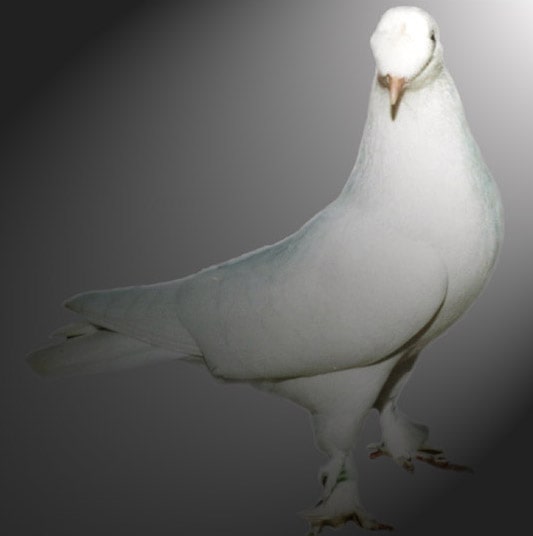
TAKLA
Takla has to be by far the most popular breed in Turkey. These pigeons are raised for their performance throughout the country where other breeds tend to stay regional. The breed comes in many colors, and the plain head, mustached, rosed, crested or double crested head ornaments. Although, in recent years mottled and grizzled birds have been showing up they are frowned upon. White color is only acceptable in some formations; white self being one. White tail markings and to a degree white head markings are also considered to be traditional. I say to a degree about the white head because it really isn't a bald head marking (which is a rather new coloration in the breed). More like a monk pattern on top of the head and only in certain sub-varieties or I should say birds from certain regions.
Each bird is called by the names based on their coloration, but they are known by their city of origin. The city they are known by is a good indication of what type of tumblers they are.
Several things measure quality of their performance: As they are low flying birds, what they do in the air is clearly visible to the fancier (this is usually the reason for many to select this breed). Young birds tumble while flying straight and at one point start to do a combination climbing & tumbling but, the performance sought after is the dive towards the loft and just before touching the ground making a helicopter like climb towards the sky, legs stretched down like they are trying to touch the ground, head down forward between wings looking down and the body 90 degrees to ground vertical take off. Every two to three feet they tumble and keep going up. Some even add to it by spinning their body around them selves or moving their legs like they are riding an invisible bicycle while going up and keeping composure.
This performance, how high they fly, how fast they fly and if they like to be flown in kits or alone really depends on what type of takla they are, more precisely what region they are from. This is also applicable to their physical qualities. Their flight time varies based on what sub-variety they belong to and can range from most popular 2 hours of flying above the rooftops to flying for 8 to 14 hours in heights where they disappear from eyesight.
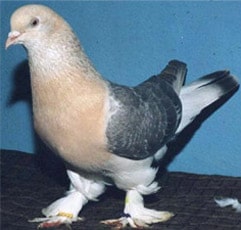
Basically, the most important quality in this breed for the breeders is their performance. Color and shape come secondary as it is in most Turkish breeds.
Each bird is called by the names based on their coloration, but they are known by their city of origin. The city they are known by is a good indication of what type of tumblers they are.Performance is measured in local competitions. Since there is no established national pigeon club in Turkey arrangements for the competitions are done by regional clubs. One of these competitions organized by a club based in the capital city Ankara has over the last few years taken the shape of a national cup, with the increased entries from other cities.
There are two basic competition styles. One is very similar to the most Western roller or tumbler breeds' competitions. Kit of minimum 4 birds flown, and they are given 20 minutes of flight time. During this time all the tumbles are counted. At the end of the time limit breeder gets so many minutes to land his birds or the scoring is off. When all birds land and are in the loft total tumble amount is divided by the number of birds in the loft and breeder's score comes up. This style is not very popular and only used for certain type of takla breeds that only perform in the air not charging the coop.The most popular competition is where only one bird is flown per breeder. This bird gets usually two hours of flight time depending on which city the competition is being held. During the flight time, only tumbles counted are the ones performed after diving towards the ground and during the climb. Here, there are a few rules: For any combination to be counted the bird must dive at least below 2 feet from the ground and climb at least 10 feet. This is the minimum. Any combination that falls short of this is not given points. There are extra points given to birds that dive and sweep the ground with their tails, that end their dive and start their climb with a tumble and the ones that spin their body 360 degrees continuously during the climb between each tumble like a screw going up. Finally, all climb combinations must end with a tumble. If the bird climbs after the last tumble and just lets go all the points for that combination is taken back. However, a slight gain of altitude after the last tumble (which is called the tie) and a small glide after it is acceptable.
Besides these, there is also a third kind of competition which is not for everyone. It is called "kapışma", literally means rumble or tussle and only the expert fanciers are allowed to participate in it. Participation is not dictated by an organization but all the fanciers in that region and there is no season for it, through out the year as long as the weather and the molting permits. For this to take place a fancier has to challenge the one of the well-known breeders. The fancier who is called upon has the right to refuse the challenge based on the qualifications of the challenger. He might say, before you come to me you have to beat this person who have lost to me. This is to prevent anybody challenging anybody. However, he may not deny so many challengers that make him look like he is just trying to get away from "kapışma". Let’s say he accepted the challenge considering the challenger as a worthy opponent. At this time, he has the right to decide what the stakes are. Because of this rule, this type of competition is not practiced by everyone. He might say if you lose you will turn over your loft to me or you will not keep pigeons for one year etc. or it might even be a sum of money. Regardless of what the stakes are the challenger has to accept it. Keeping in mind if he loses, he cannot challenge the same person again for at least another year and until he beats everyone the winner of his last challenge has beaten before, to become a formidable challenger again. Hoping, he still has birds to continue with.
Competition takes two days. First day of the fanciers, depending on what order the challenged decides, goes to the others loft and selects any bird out of his loft, excluding un-trained young birds, sick or molting birds and females worming the nests. This bird the opponent selects is the bird that will represent the owner in the competition. Since the purpose of this type of challenge is to determine who is the master breeder, every bird in the loft must be in top shape. However, during the challenging period there can be an agreement made for each fancier to seclude so many birds out of this selection process. This is not very common since no body wants the spectators to know who the weakest link in the loft is because one of them might just be the next challenger. During the selection process, each fancier tries to select the best birds out of their opponent’s loft. One of the main reasons for this is to establish himself not just as the fancier with the best birds but also the best fancier. Also, this ensures that he never hears "yes, you beat me but, really I have birds in the loft that could easily take your birds out, you just failed to pick them out". To make sure there are no questions some fanciers will show the bird they have selected to the owner and ask if this is one of his better birds. The answer usually is yes but, if there is bad blood between the two it might even be "yes, it is a good bird but, you might want to select one that is not so good for you to have a chance". When the birds flown no point system is used. After watching both birds it is simply decided by the two fancier and a few other expert fanciers who had the better bird. This type of competition was by far the best entertainment for me as a child. The events that take place prior to the competition and the results were talked about for many months and sometimes for years becoming almost like legends. Rather execrated but always intriguing. How much more fun can you have raising pigeons?
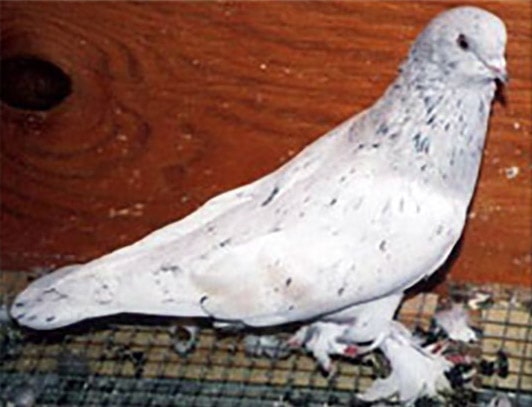
Origins of Takla
Here I wanted to talk about the origin of the Turkish Tumblers a little, known as Takla, Taqla or Taklacı by the Turkish fanciers:
Takla is originated from Central Asia, close to where Mongolia is today. They were kept by the nomad Turks over a vast region that today lies in Siberia, Western China and Kazakhstan (Turkish origin of some Russian breeds comes from here) but, they appeared in the Middle East in the tenth century as nomadic Turkish soldiers moved into this region. Finding the Middle East more pleasant than the cold steppes of Central Asia Turks remained in this area. Takla was kept for the Sultans' pleasure throughout the history. The Turkish nomads expended westward under the leadership of the sultans and brought takla everywhere they advanced. As the Seljuks took Iran and Iraq, capturing Baghdad, the capital of the old Abbasid Empire, in 1055, the takla was introduced to Middle East. As a result, the Iranian, Iraqi, Syrian, Armenian and many other known tumblers of today (some known as coop tumblers) surfaced.
The first Seljuk troops were nomads who brought all their lives with them-families, dwellings (tents), animals and belongings. For this group of people, the takla was almost like gold. They would trade with it between each other. Seljuks were soon raiding into the Byzantine Empire, which lay to the west of Iran in Anatolia. The Byzantine defeat in the great battle of Malazgirt (Manzikert) in 1071 opened the doors of Anatolia and Europe for the Turks and their prized tumblers. For five hundred years, after the fall of Istanbul (Constantinople) the Turks occupied the Balkans and the Eastern Europe (up to Vienna).
At this time many Eastern European tumbler breeds started to surface. As these countries got their independence from the Ottoman empire and Russians converted most of this area to Eastern Block, these breeds lost their identities and went through many changes to become what most of us know as European and Russian tumbler of variations. In Europe, through many genetic crossings these breeds started to look very different, and many other kinds were obtained for show purposes.
The difference and the special part of Takla comes here. It is an original breed. Though there are many color variations as you can see from the pictures, the genetics is not an acceptable form of pigeon keeping for traditional fanciers of this kind. It is said "we are not dog fanciers to create poodles and strange little animals who don't resemble what they are supposed to be. Fanciers breed for performance, beauty, intelligence within tradition.
However, I don't want to be misunderstood here. When saying genetics is not an acceptable form, I am really talking about making changes to established original breeds. In reality, genetics have been a great part of the pigeon culture in Turkey. Various breeds and colors came up with intensive genetic studies and practices over thousands of years, well before Mendel. If looked closely, most of the things today's genetic experts come up with really existed for many hundreds of years and none was found by accident. While today we have difficulties explaining the behavior of certain colorations or stabilizing so called new colorations, they were mastered by old fanciers. Through their practices breeds like Oriental Frills (Hünkari) were created long before the terminology of genetics was created. Imagine how difficult it might have been for breeders at the time to come up with breeds, which today, many fanciers utilize their qualities to create new breeds. I am sure, working with rock pigeons to come up with new breeds was a different experience.
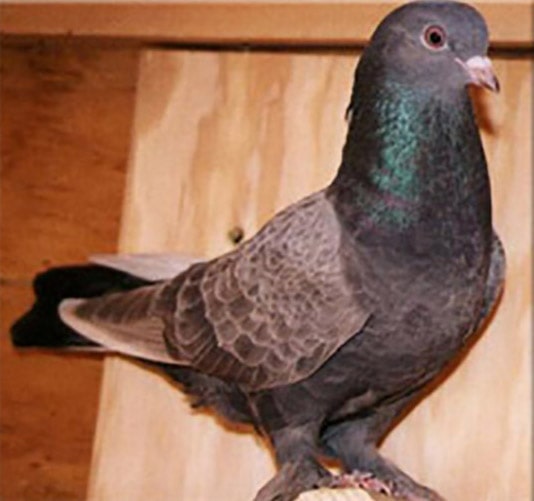
REGIONAL VARIETIES
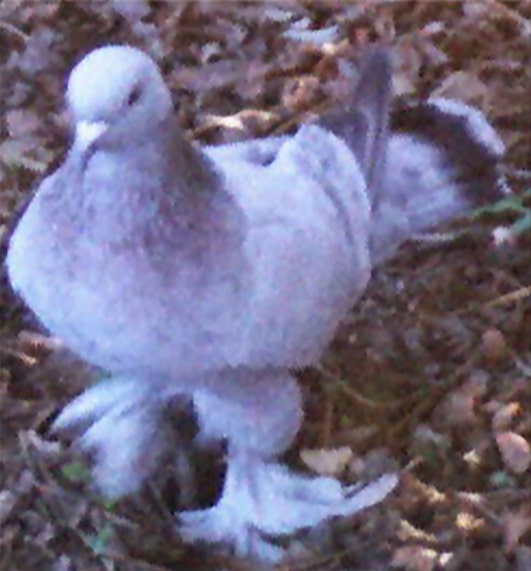
Mardin
This kind is physically the largest of them all. It looks similar to West of England Tumblers (flying kind) but caries itself higher due to longer legs. The picture above is a prime example of Mardin. Mardin comes in all shades of blue bar and checks, smoky and black self colors only. Mirrored (white) tails are very common in this breed. Its head is not decorated.
It is a very low flying breed and is a solo flier. When flown instead of gaining altitude it will spend a few hours just a few yards above the roof tops while very rarely performing in the air. After this period, it will lose altitude and start flying right above the roof tops and at times between the houses below the roof lines. Its flight is rather fast but calm, this is when you will get to see the great performance of this breed. It will charge the coop repeatedly.
Minimum standard is 40 times per flight. After each charge it will fly couple of more rounds and charge again. While charging instead of diving it will start losing altitude slowly from a distance, almost like an airplane landing and once it starts climbing it will go 40-50 yards strait up.
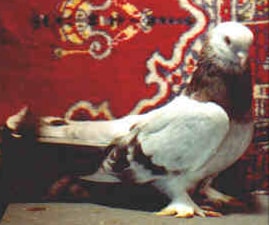
Urfa
Physical specialty of Urfa is the way it caries it's wings below the tail, some times touching the ground. Its tail is longer than Mardin by half an inch and in blacks it has a featherless ring around eyes like many Russian breeds but, less developed. Tail also stands higher than others breeds. It is head structure is rather cornered with a wide and full forehead. This breed comes with only sabuni and miski colors in addition to the blues, blacks. Like the bird above it will also come in a color what we call "açık" (open) which is similar to sabuni color but, instead of yellow chest it will have eggplant color.
This color is called "açık" because it is really a blue bar with a couple of other genes playing with it (unlike sabuni which carry a brown bar base). Urfa's head is not decorated. As it is a solo flier, its flight style is very comparable to Mardin's. Today, it is very difficult to find this breed in its pure form but, through a careful search within the old fanciers it is still possible. Even in Turkey it is a very expensive breed.
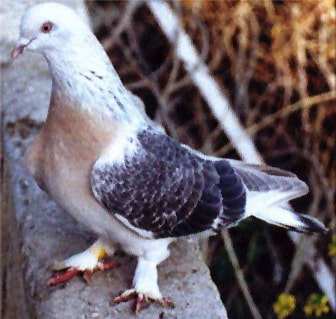
Sivas
This breed has a relatively smaller head, shorter legs and comes in all colors mentioned above. Mirrored tail is not as common but possible to see. Another marking is the white head, which is very similar to a monk marking, just on the top of the head. Colors miski (brown check with pale coloring and orange chest) and sabuni (brown bar) are believed to be first developed in this city and than mixed into rest of the takla breeds. Sivas can have a small nose crest or as we call it a rose. One significant difference of these birds is the eye color, this is the only takla type where yellow, orange and at times red eyes exist.
Main difference of Sivas comes in its performance: Unlike Mardin or Urfa it does not like to fly long hours. Max 2 hours. However, it plays harder and more often. Each combination consists of at least 8 tumble and climbs and each climb between tumbles should be a meter. It also dives in a much different style than others: It is dive look like a down-slope skier, in zigzags, wings closing and opening. Dive depth is lowest of them all and given the surroundings are sufficient, it should dive and let its tail sweep the ground for a while and than start climbing up to get into a combination.
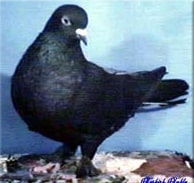
Ankara
This is the smallest of them all. Head, body and wings every thing is smaller and shorter. The beak is skinnier and longer than other types of takla. However, this size difference is not that literal. If seen by itself it can be mistaken for others. This breed comes in all colors besides what we call "gümüsh" (silver), which is a very mild yellow bar that is covered by 1/20 X 1/4 of an inch long led color markings through out the body which gets darker as the bird get older. If the dimensions don't make sense, the letter "I" is little shorter than what the markings look like.
This color comes only in males in breeds that have it. Another color missing is the khaki or brown self in this breed. All these colors come in a dusty shade in Ankara (browns that can be seen in Ankara are in reality a formation of the blue gene but, not a true brown.) Blues are very similar to wild type and dirty blue, blacks never bright but a light tone of black almost like a black bar dun. Reds, yellows and others come in ash and never with clear white feathers on the wing or tail. Smokey and açık colors are some of the most common colors in this breed.
Ankara also differs in performance: It tumbles are very hard and quick. Between each tumble there is a very little climb, in fact if looked carefully, there is a slight altitude loss after each tumble. Ankara performs harder than any breed in Turkey. Its combinations are shorter than all but, full of tumbles. Good bloodlines must get daily exercise, or it becomes unable to fly from tumbling.
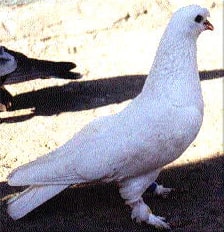
Antalya
This breed is the tallest one of them, with its head, similar to Ankara's, smaller and a narrower chest. It comes in all traditional colors and carries all head ornaments, together or single crested. Breeders of this region claim to be the origin of gümüsh and khaki colors. This breed likes to fly higher, with quick wing strokes like Urfa, than others and does not kit well. Its combinations are longer than any breed but do not dive to charge the coop.
It is the ancestor of today's Syrian Coop Tumbler by the way of Seljuks. Today it is one of the rarest breeds of takla. Result of the years of migration to this city from all over Turkey because of its Mediterranean Rivera climate, many different takla breeds were introduced to the city and were cross bred with Antalya. If it is possible to find this breed in it is pure form it is outside of its own region in the hands a few fanciers.
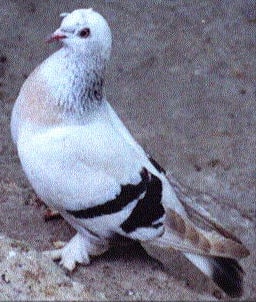
Diyarbakır
This one is a chubby kind of takla with a relatively shorter neck and legs. Its body is unlike most pigeon breeds is flat looking from front almost an ellipse, horizontally wider. Diyarbakır comes in all colors in most bright tones. It's head ornaments also come in different shapes. Beak crest, rose, besides coming in traditional shape, comes in different shapes as a "coin rose" similar to Bokhara trumpeters' or "side swap' like the bird on this picture, brushed to one side of the face. The head crest extends from cheek to cheek and sometimes has a curl at the top bending towards the beak.
Muffs can be as short as the picture shows to as long as several inches. As far as performance goes Diyarbakır is not very competitive. Even though, it is a fairly good performer, it's raised primarily for its looks. Diyarbakır also is a region of Turkey where many tumbler looking breeds raised for their physical qualities or voices. One can consider Diyarbakır the pigeon capital of Turkey.
Konya: Physically it is very similar to Mardin but its beak is smaller like the Antalya taklas. Performance vise they are very comparable to Antalya but, instead of flying solo they prefer to be flown in kits.
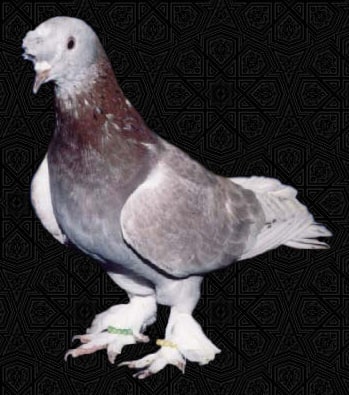
KEEPING TAKLA
For many people takla, with its show like physical qualities combined with aerial performance, is an attractive breed to keep. This probably is the reason for it to be the dominant breed in Turkey also. However, it really is not a breed for everybody. This breed requires a high level of commitment, patience and time when it comes to performance. For one thing, not everyone has the space or time to go through an extensive training period with each bird and this is understandable. Once a breeder determines that he/she has the right place and adequate time for this breed the question of patience comes to mind. In USA, we are used to breeds like Birminghams or the racers. So, our measurement for the heavy training is usually based on these breeds. In all honesty, a person that prepares him/herself for takla training with expectations similar to these breeds destined to a long and frustrating journey.
This is similar to many people that took on the Oriental rollers thinking they are rollers just like Birminghams. A Birmingham should get into a fair level of performance rather quickly and this makes it more fulfilling since you get to see the results in a short time, with minimal effort (Of course even in these breeds, when it comes to championship level of performance the level of effort gets much higher.) Well, with a young takla you will never be sure that it has reached its full potential until after at least it has reached maturity and fed its own babies for two rounds. For many people this is a long time to wait. Some will say, time is not an issue, I hear this usually from breeders of racing pigeons. While it is true that the racers spend a lot of time training their birds for the races, it is also true that driving your birds to a distance location, or shipping them there, to release them and waiting for them to return home is not really the type of training we are talking about here. Observing each bird’s behavior individually and adjusting their flight schedule accordingly day after day can take a toll on anyone. Relaxing the training for a week or so at the wrong time can result in a kit of three huggers who are impossible to train now.
Seeing many of the young birds starting to show their performances and nothing from some others can drive a fancier who is new to this breed to get rid of these lazy ones which will blossom in the hands of another fancier and become exceptional performers. I can go on and on. Really, my intention here is not to scare potential future breeders but to encourage them to make vise decisions. One of the main reasons for this is the prices of good taklas. Looking around you might find good bargains but in average a young bird's price will start from $100 and a trained adult bird's from $500 each. When you add to this the reluctance of Turkish breeders selling good birds to people who are not Turkish, with worries of their prized birds becoming another casualty in the show biz, it becomes an investment to be a takla breeder.
I have seen many seasoned breeders asking for birds just to give up in a season. I would say, if you have never kept another performing breed, start with something easy. I don't mean this in any way as belittling. You have to make sure, you and your surroundings (trees, cables preventing good flight zone, hawk infested area, etc.) are up to the challenge. There are many other performing breeds that won't frustrate you as much as takla can but, still require a good amount of work. Many of the diving breeds like döneks (here, I am using the name Dönek as a referance to the birds which are called with this name in USA, not the breed we call Dönek) and kelebeks are good measurement of what is in store. Here, talking about the divers, I would caution you for Adana Dewlaps. This is another breed that require extensive levels of keeper's attention. Well, so much for the warnings and drawing gloomy pictures. Bottom line, takla can be a very fulfilling experience for any breeder, as long as one knows what to expect.
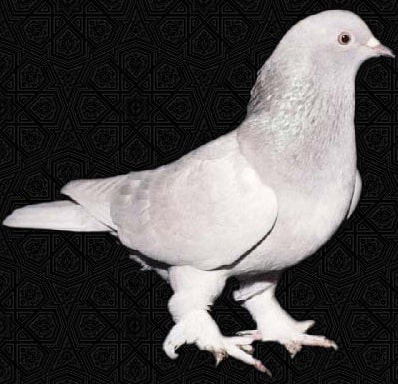
Now, you have some takla babies and want to start training them. At this moment you have to remember takla is an ancient breed and has been kept with same qualities for many hundreds of years. So, for a takla breeder there is no comfort zone of cull birds. If your birds are pure and you know that they were never broken (term we use for mixing with other breeds for any reason), you will not get bad birds. Of course, this in no way means every bird you get will perform in the highest level. Because of this, it is very important to get your stock birds from a well-known fancier who fly his/her birds for performance. Even though, it is rather difficult to do, because of the size of USA, best way to get good birds is to visit the fancier and see his birds in action. Keep in mind that you are going to give a lot of your valuable time to this breed and the last thing you want to do is start with the wrong birds.
Do your homework before buying any birds. Talk to others who bought birds from the fancier you are about to get birds from and always look for a guarantee when buying. Every body say their birds are the best, they are from a recent import line, or they won this competition, etc. However, a person demanding such high prices for a pigeon should also be able to say if they don't live up to your expectations bring them and I will give your money back. For the process of getting the birds, my last comment is to look for quality not for quantity. Sometimes, it is a better purchase to get a pair of young birds from a well-known fancier instead of spending same amount of money and getting five pairs of adult birds from anyone. Start with less but, start with right.
Now, let’s go back to our young birds and their training. As in many breeds, first challenge is to get them used to being outside of the loft. Here you can use any one of the techniques used for other breeds. The one I find easy is to remove the young birds from the nest boxes and put them on the loft floor as soon as they are able to eat on their own. To determine this, I start dumping very little amount of feed in front of them in the nest while the parents eat down on the floor from the feeders. Even if the young ones don't pay attention to the seeds in front of them, this is a good way for them to learn what to do by watching their parents coming into the box to feed them and peck at the grains on the floor.
When they are removed from the nest and put on the loft floor, they will soon start eating out of the feeders. There really is no need to worry if they are getting enough feed since the parents will continue to feed them there also. One thing to watch for is if they learn to drink out of the water containers. If they are completely on their own eating but still relentlessly chasing their parents around, it is a good chance they haven't figured out where the water is or if they need some. One thing for sure, even if their crop is full of feed, they are still in need of something. As you observe these young birds, if noticed some are not able to drink on their own, the solution is simple; catch the young bird and holding it in your hand dip its beak into the water. If this was the problem, it will start drinking like there is no tomorrow. In fact, I have seen a few of them fall in love with the water container. They just would not leave the site of it. At times they would drink so much water, once they pulled their head out of it, they would have great difficulties finding their balance to stand up straight with all the water wobbling around their crop.
Rather funny site to watch. Once the young birds are on the floor, it is easy for them to wander outside with the breeders when I open the door for their daily outing. I don't fly most of my breeders (since they are mostly imports, it would be very difficult for me to replace them if something goes wrong in the air) but still try to let them out every day to make sure they have contact with earth to gather the necessary nutrition, minerals and if they want to, fly a little bit. During the time adults graze outside of the loft, young birds, rather reluctant at first, eventually come out. Since they still have not completed growing their under wing feathers, they really can't fly but, being able to go out and come back in gives them the confidence to be out in the dangerous world, knowing they can always run back in to the safety of the loft.
As the time passes, they start rushing out with the rest of the birds. At this point, I move them into the flight lofts. For a brief period, they work as droppers for the other young birds in training. To call the fliers down, I open the door of the loft and these guys come out. Since they like to exercise their wings and fly around the yard rather crazy, they work out to be perfect droppers to get the attention of the young fliers. During this phase, I watch them very closely. If, I see one that likes to fly up and take a trip around the house with the landing birds, I separate it from the others (in my mind) as being ready to fly. This usually comes right after they complete all their under-wing feathers.
The following day, I get this bird and throw it in to the young bird team right before they land, as they are getting tired and flying low at this point. As soon as the new bird takes a round trip or two around the house, I open the door to let the others out and call the flying birds down. Since the new flier has been in the yard for a while and flying around probably landed on the loft's roof a few times, it is somewhat familiar with the surroundings. This makes it easy for him to land after flying quick few rounds around the house where it can see the loft from all directions.
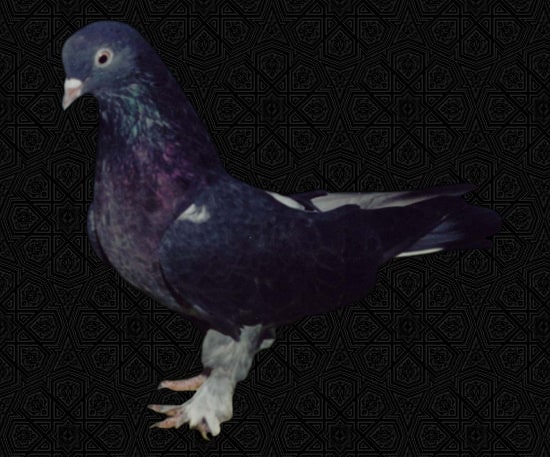
Once this phase is passed, the real training starts:Now, let’s go back to our young birds and their training.As in many breeds, first challenge is to get them used to being outside of the loft. Here you can use any one of the techniques used for other breeds. The one I find easy is to remove the young birds from the nest boxes and put them on the loft floor as soon as they are able to eat on their own. To determine this, I start dumping very little amount of feed in front of them in the nest while the parents eat down on the floor from the feeders. Even if the young ones don't pay attention to the seeds in front of them, this is a good way for them to learn what to do by watching their parents coming into the box to feed them and peck at the grains on the floor. When they are removed from the nest and put on the loft floor, they will soon start eating out of the feeders. There really is no need to worry if they are getting enough feed since the parents will continue to feed them there also. One thing to watch for is if they learn to drink out of the water containers.
If they are completely on their own eating but still relentlessly chasing their parents around, it is a good chance they haven't figured out where the water is or if they need some. One thing for sure, even if their crop is full of feed, they are still in need of something. As you observe these young birds, if noticed some are not able to drink on their own, the solution is simple; catch the young bird and holding it in your hand dip its beak into the water. If this was the problem, it will start drinking like there is no tomorrow. In fact, I have seen a few of them fall in love with the water container. They just would not leave the site of it. At times they would drink so much water, once they pulled their head out of it, they would have great difficulties finding their balance to stand up straight with all the water wobbling around their crop. Rather funny site to watch.
Once the young birds are on the floor, it is easy for them to wander outside with the breeders when I open the door for their daily outing. I don't fly most of my breeders (since they are mostly imports, it would be very difficult for me to replace them if something goes wrong in the air) but still try to let them out every day to make sure they have contact with earth to gather the necessary nutrition, minerals and if they want to, fly a little bit. During the time adults graze outside of the loft, young birds, rather reluctant at first, eventually come out. Since they still have not completed growing their under wing feathers, they really can't fly but, being able to go out and come back in gives them the confidence to be out in the dangerous world, knowing they can always run back in to the safety of the loft
As the time passes, they start rushing out with the rest of the birds. At this point, I move them into the flight lofts. For a brief period, they work as droppers for the other young birds in training. To call the fliers down, I open the door of the loft and these guys come out. Since they like to exercise their wings and fly around the yard rather crazy, they work out to be perfect droppers to get the attention of the young fliers. During this phase, I watch them very closely. If, I see one that likes to fly up and take a trip around the house with the landing birds, I separate it from the others (in my mind) as being ready to fly. This usually comes right after they complete all their under-wing feathers. The following day, I get this bird and throw it in to the young bird team right before they land, as they are getting tired and flying low at this point. As soon as the new bird takes a round trip or two around the house, I open the door to let the others out and call the flying birds down. Since the new flier has been in the yard for a while and flying around probably landed on the loft's roof a few times, it is somewhat familiar with the surroundings. This makes it easy for him to land after flying quick few rounds around the house where it can see the loft from all directions.
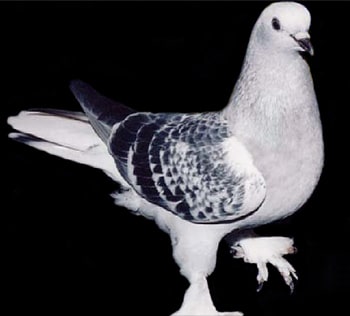
Once this phase is passed, the real training starts: Training format is rather simple. Get each bird to fly as long as they can and increase their flight time every day or so. To do this, I find it more productive to fly each young bird with the old birds for a while. There are a couple of reasons for this: First of all, the old birds fly in a slower, calmer pace and kit well. If the young birds flown together, they tend to get scared and fly fast and crazy, like there is a hawk on their tail. It is important to get rid of this as soon as possible, so they can focus on their performance development. Even a single young bird gets the most seasoned team of birds a little nervous at the beginning. As the young bird tries to kit closely with the others it gets too close or even run into them. Getting too close (or thinking it is), it tries to avoid collision by maneuvering the best he knows and makes one of those moves the old birds associate with avoiding a hawk.
This causes also the old birds to start getting out of the formation and flying faster with many of their hawk avoidance maneuvers. Well, this doesn't last long after a few days the young bird adjusts and becomes a part of the kit. If flown with the other young birds, this phase will take much longer. It may not always be apparent to the eye but, the nervousness and fast flight prevents them from practicing their tumbling skills more frequently, which in return extends the training period. Another reason for a single young bird to be flown with old birds is learning by watching. Because of this, I select certain old birds to train young birds for the season. There is never a top performer in this group. In fact, to have a good teacher team, I cut some of the birds training off halfway the previous year so they are in a certain level of performance only. Some just tumble going straight and some just do vertical tumbling combinations of a few tumbles but, they are always the calmest fliers. This also should point out the importance of timely training. These old birds regardless of how many young birds they train over the years never become fully performing birds.
Once their development is stopped in a crucial time in their life, there really isn't much of a chance of going back. This is also true for starting the young birds' training late. Once they have completed growing all of their feathers, they should be flying. Older they get the harder it gets to train them. They tend to get overweight and lazy. Most importantly their chest muscles continue their development when they need to be developed during flight to take a different shape to allow them for their vertical climbs. Bottom line is the young bird are flown with these older birds so it can see the birds around him perform tumbles and starts to do what they do quicker than they naturally would. To be honest, I don't think it is necessary to train your young birds in the way I do, up to this point. The things I do is to speed up their development and maximize their performance. Which in return takes more time from me daily bases and allow me to train fewer number of birds each year but, I get to see each bird’s potential sooner than later. You can train young birds as a group or even without any old birds.
They will sooner or later start to perform. I just want to share what I do, so you get an idea of alternatives out there. If you are just starting with this breed and have only a few young birds to fly, you can utilize another breed to train them for a while also. Rollers, racers or any other flying breed. Only thing to watch for is, at the beginning fly them with birds that are not going to take them up to high altitudes. You want to get the young birds' chest muscles to develop in this initial phase of the training so they can fly for longer periods but, if they start flying with birds that take them so high, they will get tired sooner or later and separate themselves from the kit to land. This could result in loss of young birds or having them develop bad habits such as landing on neighbor's roof tops, trees and cables, which in long term will give you problems trying to get them to fly longer, if they get used to land anywhere, they want whenever they want.
Now you have a young bird flying more or less calmly for around ten minutes. At this point, you can include another young bird to the team. This means, if you have a few young birds, you might have to fly a few times a day. Which is not a problem since the flights are short and you can fly one after another. After a while, when all of your young birds are flying well, you can take the old birds out of the team and fly the youngsters in their own kit. This is just a choice. Sometimes, I keep them together all season and sometimes separate them so I can use the old bird team to develop a few more squeakers. During these training flights, I only release the rest of the birds out of the loft when I want the flying birds to land. Young birds get accustomed to this signal. Since they have seen the old birds land as soon as the birds come out of the loft, they start doing the same thing. I find this to be very important to be able to control the kit..
When all the birds land, I let them graze around for a while and then walk them to the loft. To walk them I use a stick but, taklas are not like döneks when it comes to move them around. If they want to be out, it would be very difficult to get some of them to go in. Here comes the importance of feed control. At the beginning of each young birds' training, I fly them when they are not hungry. This is to encourage them to fly. Expecting feed, they should not become glued to the loft, when they should be flying. Besides, they tumble for fun, since tumbling is not a reflex yet for them and flying hungry is not that much fun. However, as soon as they can fly for about five minutes or so, I start flying them hungry. Not overnight but, gradually reducing the feed. This is again done to have a little more control over them. When they are flown hungry, they don't try to land on roof tops or trees but, want to land in front of the loft knowing soon there will be food. This also comes handy when you want to put them back into the loft. At the beginning, I simply put some feed in to the feeder and make gestures and sounds of walking them. They respond to the feed but with time they also associate my moves and sounds with food. After a while, walking them with a stick or simply walking with them while whistling, or whatever sound you choose to make, becomes good enough to get them into the loft.
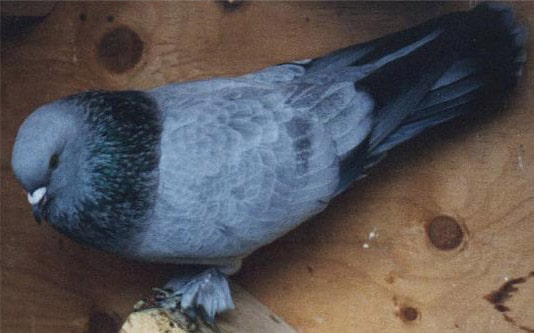
Going back to the flight training, let’s look at the young birds' flight; They will soon start clapping their wings a few times and seem to glide after this move. This clapping is very common in many of the Eastern tumbler breeds. It will soon be followed by riding the tail. Riding the tail is almost like a free fall. After few heavy wing clapping the bird will drop vertically on its tail gliding down. This move will get deeper and deeper as they practice it. This is a sure sign of them getting ready for tumbling. However, this phase of the training can take a long time depending on the bird. It can take 2 weeks to 2 months and sometimes continue even after they are able to tumble for a while. During this phase, it is important to push each young bird to fly at least 15 minutes. Again, this is crucial for their chest muscles' development. After this, will come the funny phase, where the tail riding will start to become half tumbles and sometimes a full tumble but, always with not much control. Flying one direction, attempt a tumble, then you are going to what direction, who knows? It is just a pleasure to watch this. As they get more flight time, they will get their tumbles in a better shape.
Once the tumble is OK. they will start tightening it up. As it gets tighter, they will stop losing altitude with each tumble. When the tumbles are just right, you will start hearing a cracking sound with each tumble. Now you will get to see the purpose of their wing clapping before tumbles. Wing clapping starts to pull them up a little, before the tumbles. As they get more flight time, they will start putting two or more tumbles together to work on their combinations and start to show their true style. Good ones will put many combinations tumble, climb, tumble, climb... At this point in the training, you will notice as you let the rest of the birds out of the loft only some of the birds land. This is a good time to measure how long each one of these birds fly after the others land. Now the training changes a little. From now on, I fly the longer flying birds first, as much time as they landed after the other birds. At this point I will fly the rest of the kit. As the time passes you might get several groups of birds in the kit with different flight times. You will get the best results by accommodating this by flying the ones that fly the shortest the latest. Let’s say you have a few of them flying for 15 minutes, couple of them for 25 and another group for 40 minutes. I would fly the 40-minute ones first. After 15 minutes I will also send up the 25 minute and 10 minutes after that the 15-minute fliers. This way you will get each one of the birds to land around the same time and, by not having early birds, continue to increase their flight time.
Around this phase of the training, you will start to see some of your birds separating from the kit and fly by themselves every once in a while. As the days pass these birds will start flying alone more and more. No need to be alarmed. Intensions of the training is not to create a tight flying kit. In fact, it is not to create a kit at all. Regardless of what you do those birds will continue to fly separate and maybe together with another loner. If you know the parents of each bird, you can actually tell which ones will do this even before the training. They are simply different type of performers than others. You can still continue to train with the same formation to increase the flight time. Loners will continue to be loners and the kit fliers will stick together. As you fly them, you might see the birds start flying together and after a while the loners separate. Following this the kitting birds will gain altitude and go to the heights you can barely see them. It is still OK. You are not going to lose any birds. Highfliers will soon loose altitude and fly right above the roof tops and then go up again. That's what they like to do. Loners in the meantime will start to fly for longer periods than the kit. They will land long after you have released the droppers. These guys are the ones that will end up flying in low altitudes and constantly lower themselves like they are going to land and climb up with their combinations. You can try to fly these guys alone for a change.
You might find out some of them actually has a lot to show you. As they get really good at this, they won't be able to land. Every time, they lower themselves to land, their instinct will make them climb up. Because the position of their head, legs and wings to land is identical for their climbing posture. So, just fly them and go sit down. They will put a show for you. (It is interesting how they manage to crush-land with the sight of a hawk.) Your kitting birds also will show similar performances but they will also like to perform in a kit all together without any dives towards the loft. As one starts its climb the rest will follow it. It is almost like fireworks in the sky and rather loud too. I am trying to differentiate these two different types of performers but, you will also get some that carry characteristics of both groups. In reality all these depend on the blood lines you have and more specifically what city of origin each family has. If you have birds from Ankara, you will for sure get a group of birds that fly together in ever changing altitudes and fill their flight time with tumbles. On the other hand, if you have your birds from the cities of Mardin or Urfa, you are most likely going to see some heavy artillery. Low flying but extremely long climbing birds. As far as the flight time, I prefer my birds to fly around 2 hours. This is a good period of time for a kit but, if you have one of the loners, who are supposed to be flown alone after their training period, there really is no limit on the time of flight.
I have seen ones fly over 10 hours and heard of some way over that. However, endurance flying is not what we are looking for in this breed. So, no need to push these birds to fly for long hours. They simply will but, perform less. So, you will get a bird that flies for 10 hours and only perform the last two hours. First 8 hours you might see a combination here and there, but it just doesn't do it for me. As you fly these birds always have the rest of the birds on the ground. This will keep them around the loft charging and somewhat control the flight time. Well, all this might sound too much for some and it can be. However, you don't have to do everything I talk about. I have a friend in New York, who takes his young birds to another loft on top of his shop building and keeps them outside all day. At the end of the day, before he goes home, he goes up and puts them back in to the loft. That is the training his bird get. They are outside all day and as they see crows, hawks and cats they take off. Believe it or not he gets some very good performing birds. He loses many birds in the process and have many tree huggers at the end but not everybody has the time or the patience. As a final note, one thing to keep in mind is to keep flying. Exercise is important, regardless of the season. Very good blood lines will become TUTUK (stuck) with the absence of frequent flying and become unable to fly from tumbling. These birds tumble in the coop or on the floor. Some consider this a good skill but, keep in mind: Pigeon is a bird. It must fly. They are not chickens.
